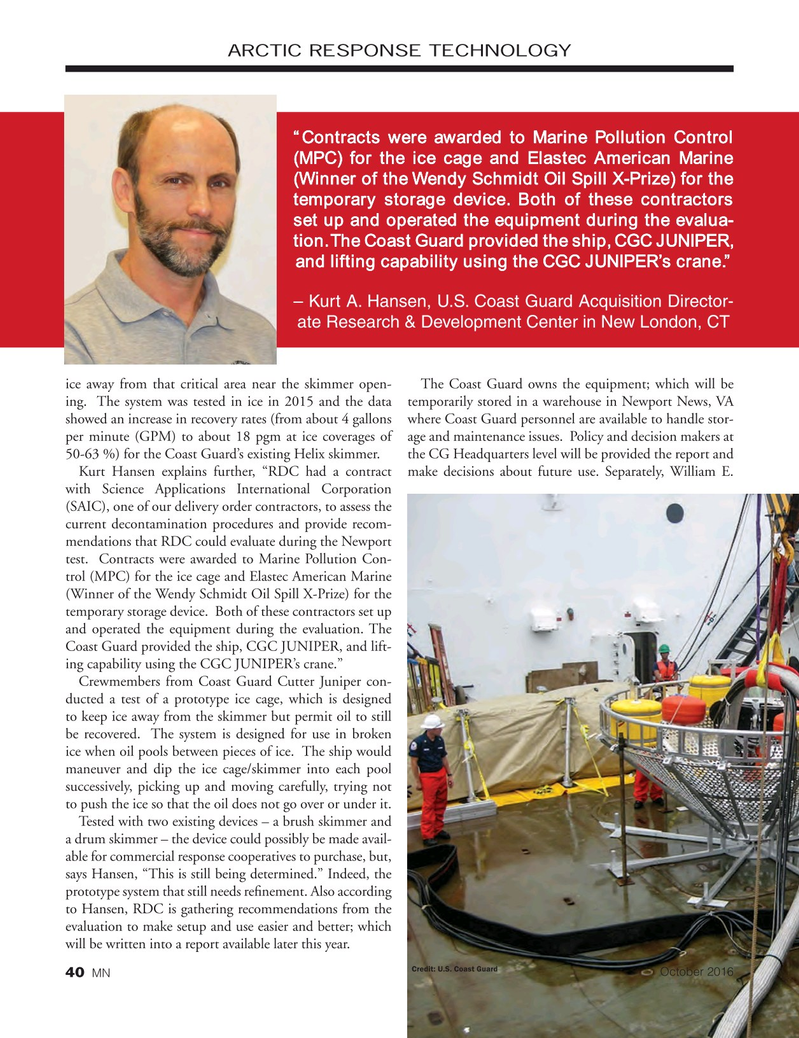
Page 40: of Marine News Magazine (October 2016)
Salvage & Spill Response
Read this page in Pdf, Flash or Html5 edition of October 2016 Marine News Magazine
ARCTIC RESPONSE TECHNOLOGY “Contracts were awarded to Marine Pollution Control (MPC) for the ice cage and Elastec American Marine (Winner of the Wendy Schmidt Oil Spill X-Prize) for the temporary storage device. Both of these contractors set up and operated the equipment during the evalua- tion. The Coast Guard provided the ship, CGC JUNIPER, and lifting capability using the CGC JUNIPER’s crane.” – Kurt A. Hansen, U.S. Coast Guard Acquisition Director- ate Research & Development Center in New London, CT ice away from that critical area near the skimmer open- The Coast Guard owns the equipment; which will be ing. The system was tested in ice in 2015 and the data temporarily stored in a warehouse in Newport News, VA showed an increase in recovery rates (from about 4 gallons where Coast Guard personnel are available to handle stor- per minute (GPM) to about 18 pgm at ice coverages of age and maintenance issues. Policy and decision makers at 50-63 %) for the Coast Guard’s existing Helix skimmer. the CG Headquarters level will be provided the report and
Kurt Hansen explains further, “RDC had a contract make decisions about future use. Separately, William E. with Science Applications International Corporation (SAIC), one of our delivery order contractors, to assess the current decontamination procedures and provide recom- mendations that RDC could evaluate during the Newport test. Contracts were awarded to Marine Pollution Con- trol (MPC) for the ice cage and Elastec American Marine (Winner of the Wendy Schmidt Oil Spill X-Prize) for the temporary storage device. Both of these contractors set up and operated the equipment during the evaluation. The
Coast Guard provided the ship, CGC JUNIPER, and lift- ing capability using the CGC JUNIPER’s crane.”
Crewmembers from Coast Guard Cutter Juniper con- ducted a test of a prototype ice cage, which is designed to keep ice away from the skimmer but permit oil to still be recovered. The system is designed for use in broken ice when oil pools between pieces of ice. The ship would maneuver and dip the ice cage/skimmer into each pool successively, picking up and moving carefully, trying not to push the ice so that the oil does not go over or under it.
Tested with two existing devices – a brush skimmer and a drum skimmer – the device could possibly be made avail- able for commercial response cooperatives to purchase, but, says Hansen, “This is still being determined.” Indeed, the prototype system that still needs re? nement. Also according to Hansen, RDC is gathering recommendations from the evaluation to make setup and use easier and better; which will be written into a report available later this year.
Credit: U.S. Coast Guard
October 2016
MN 40
MN Oct16 Layout 32-49.indd 40 9/21/2016 3:26:09 PM

 39
39

 41
41
